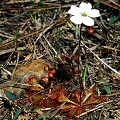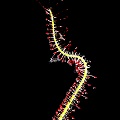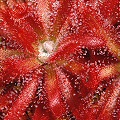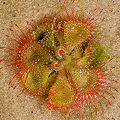| Latin American species1 | |
|---|---|
|
D. amazonica D. arenicola D. ascendens8 D. biflora D. brevifolia5 D. camporupestris D. capillaris5 D. cayennensis7 D. cendeensis D. chimaera8 D. chrysolepis D. communis D. condor D. esmeraldae D. felix D. graminifolia D. grantsaui D. graomogolensis8 D. hirtella var. hirtella D. hirtella var. lutescens D. hirticalyx D. intermedia6 |
D. kaieteurensis D. latifolia8 D. magnifica D. meristocaulis2 D. montana9 D. peruensis D. quartzicola D. riparia8 D. roraimae D. sessilifolia4 D. schwackei9? D. solaris D. spiralis D. spirocalyx9 D. tentaculata9 D. tomentosa var. tomentosa9 D. tomentosa var. glabrata9 D. uniflora3 D. villosa8 D. viridis D. yutajensis |
|
1All in Drosera sect. Drosera unless otherwise noted. 2In Drosera sect. Meristocaulis. 3In Drosera sect. Psychophila. 4In Drosera sect. Thelocalyx. 5Also occurs in USA, Mexico, Central America, and Cuba. 6Ranges through Europe, USA, Canada, and Cuba. 7Lumped with D. colombiana and the Panamanian D. panamensis. 8A member of the D. villosa complex. 9A member of the D. montana complex. |
|

Drosera brevifolia

Drosera graminifolia

Drosera graomogolensis
Q: Latin American Drosera
A: South America is a hotspot for Drosera biodiversity,
and I am quite confident that there are many species there that have not yet been described. The table on this page
lists all the species of South America (including its offshore islands), Central America,
and a bit of the Caribbean. Some of these plants are morphologically variable within their geographic ranges,
and have been divided into
varieties, regrouped, and shuffled around. In matters of Brazilian Drosera,
I follow the perspectives of Fernando Rivadavia.
For the most part, Drosera has not apparently invaded the broad areas in South America that are
occupied by dense rainforests. This is presumably a limitation imposed by low light levels on the forest floor; there are no
known epiphytic Drosera.
Some of the Latin American species
are small and not particularly showy, but some are quite fabulous. Drosera graomogolensis in
particular is frequently cited as one of the prettiest species in the genus. (Until recently, this species was treated as
a variety of Drosera villosa.)
The majority of Latin American species are perennial species, although some are relatively short-lived. For the most part they
are tropical in cultivation. However, some species---especially those from the Guiana Highlands---probably respond best to cooler
conditions as befits their highland origins. Plants with thick roots can be easily propagated via root cuttings.
Drosera communis
A rather nondescript rosetted sundew; I mention it here for two reasons.
First, it includes "Drosera parvifolia St.Hil."
Second, while past treatments of D. communis have split into two varieties, it turns out that
"D. communis var. pauciflora Eichler"
is in fact simply D. montana. So, D. communis has no
infraspecific ranks.
Drosera magnifica
A spectacular species, truly deserving of its specific epithet. It looks like a
D. graminifolia on steroids.
Drosera meristocaulis
This bizarre plant was refound in the wild by
Fernando Rivadavia. This plant is an interesting little sundew that, oddly enough, seems more akin to one of the Australian
pygmy species than any others.

Drosera sessilifolia
Drosera montana
This plant has been subject to a number of revisions and changes. As I
follow the perspective of Rivadavia, I have no subspecies for this plant, but put it in a complex of related species
including D. tomentosa, D. schwackei, and
D. tentaculata.
Drosera sessilifolia
This looks almost identical to
Drosera burmannii of Australia and Asia. Very odd!
Drosera solaris
To my eyes, one of the prettiest
Drosera of all. I simply adore the color contrast between yellow petioles and red lamina--at least how
it occurs in the wild (cultivated plants don't seem to have that same appearance).
Drosera uniflora
This is an oddity...this plant is in a section shared only by the New Zealand
D. stenopetala. Some strange long-range dispersal must have happened!
Drosera ×fontinalis
A naturally occurring hybrid of
Drosera grantsaui×tomentosa.
Page citations: Rice, B.A. 2006a; Lowrie, A. et al. 2017a, 2017b; Rivadavia, F. 2008, 2009;
Rivadavia, F. et al. 2009; Robinson, A. et al. 2017; Schlauer, J. 1996, 2002.